
The Piccadilly line is a deep-level London Underground line running from the north to the west of London. It has two branches, which split at Acton Town, and serves 53 stations. The line serves Heathrow Airport, and some of its stations are near tourist attractions such as Piccadilly Circus and Buckingham Palace. The District and Metropolitan lines share some sections of track with the Piccadilly line. Printed in dark blue on the Tube map, it is the fourth busiest line on the Underground network, with over 210 million passenger journeys in 2011/12.
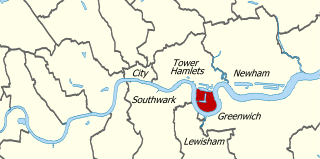
The Isle of Dogs is a large peninsula bounded on three sides by a large meander in the River Thames in East London, England, which includes the Cubitt Town, Millwall and Canary Wharf districts. The area was historically part of the Manor, Hamlet, Parish and, for a time, the wider borough of Poplar. The name had no official status until the 1987 creation of the Isle of Dogs Neighbourhood by Tower Hamlets London Borough Council. It has been known locally as simply "the Island" since the 19th century.

Lewisham is a London borough in south-east London; it forms part of Inner London. The principal settlement of the borough is Lewisham. The local authority is Lewisham London Borough Council, based in Catford. The Prime Meridian passes through Lewisham. Blackheath, Goldsmiths, University of London and Millwall F.C. are located within the borough.

Poplar was a local government district in the metropolitan area of London, England. It was formed as a district of the Metropolis in 1855 and became a metropolitan borough in the County of London in 1900. It comprised Poplar, Millwall, Bromley-by-Bow and Bow as well as Old Ford, Fish Island and Cubitt Town.

Millwall is a district on the western and southern side of the Isle of Dogs, in east London, England, in the London Borough of Tower Hamlets. It lies to the immediate south of Canary Wharf and Limehouse, north of Greenwich and Deptford, east of Rotherhithe, west of Cubitt Town, and has a long shoreline along London's Tideway, part of the River Thames. It was part of the County of Middlesex and from 1889 the County of London following the passing of the Local Government Act 1888, it later became part of Greater London in 1965.

Cubitt Town is a district on the eastern side of the Isle of Dogs in London, England. This part of the former Metropolitan Borough of Poplar was redeveloped as part of the Port of London in the 1840s and 1850s by William Cubitt, Lord Mayor of London (1860–1862), after whom it is named. It is on the east of the Isle, facing the Royal Borough of Greenwich across the River Thames. To the west is Millwall, to the east and south is Greenwich, to the northwest Canary Wharf, and to the north — across the Blue Bridge — is Blackwall. The district is situated within the Blackwall & Cubitt Town Ward of Tower Hamlets London Borough Council.

The Den is a football stadium in Bermondsey, south-east London, and the home of Millwall Football Club. The Den is adjacent to the South London railway originating at London Bridge, and a quarter-of-a-mile from the Old Den, which it replaced in 1993.

The Manor Ground located in Plumstead, south east London was a football stadium. This arena was the home of football club Royal Arsenal, which was later named Woolwich Arsenal, and as such came to be known as Arsenal F.C.
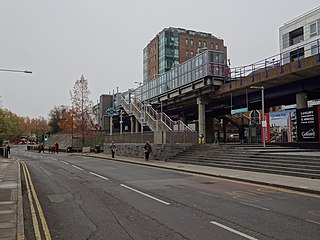
Millwall Docks was a railway station located in the Millwall area of the Isle of Dogs in east London. It was between South Dock and North Greenwich stations on the Millwall Extension Railway (MER) branch of the London and Blackwall Railway (LBR). It opened in December 1871 and was situated on the corner of Glengall Road and East Ferry Road, serving the Millwall Docks.
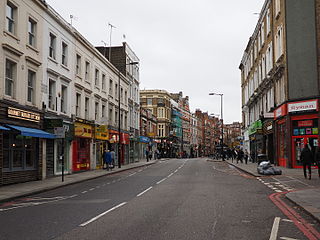
The A3220 is a primary A road in London. It runs north from Clapham Common to the A40 Westway at Ladbroke Grove.

National Cycle Route 1 is a route of the National Cycle Network, running from Dover to Tain. The 1,264 mi-long (2,034-kilometre) cycle-path is located in the United Kingdom.
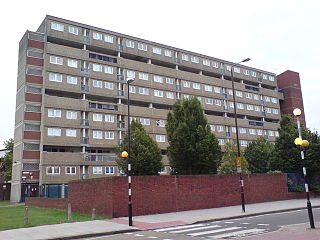
St John's Estate is a housing scheme in Cubitt Town, on the Isle of Dogs in London. Centred on the triangle formed by Manchester Road, East Ferry Road and Glengall Grove, it was developed by Poplar Borough Council after the Second World War. It is served by Crossharbour DLR station to which it is adjacent.
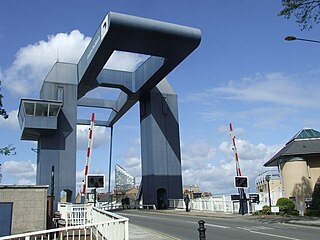
The A1206, also known as the Isle of Dogs Distributor Road, is a crescent-shaped ring road around the Isle of Dogs, in the East End of London. It is made up of Westferry Road, Manchester Road and Prestons Road and is the main road through the area, connecting parts of the London Docklands.
London Yard was a shipyard in London, in use between around 1856 and 1908 by various shipbuilding companies, including Westwood, Baillie and Yarrow Shipbuilders.

Glengall Bridge is a bridge in the Millwall Inner Dock, Isle of Dogs, London, England, near the Crossharbour DLR station. It is located in the London Borough of Tower Hamlets. The present Dutch-style double-leaf bascule bridge opened in 1990, resembling Langlois Bridge at Arles.The contract to manufacture the bridge across Millwall Dock was awarded to Butterley Engineering Company Ltd; of Ripley, Derbyshire.

The Barkantine Estate is a large social housing estate in Millwall built by the London County Council in the lates 1960's, located on the Isle of Dogs and is also composed of a pub, shopping promenade and park.
John Francis Gilbertson (1882–1947) was an English politician who served as mayor of Poplar, 1938–9. He represented Cubitt Town as a Labour Councillor from 1933.
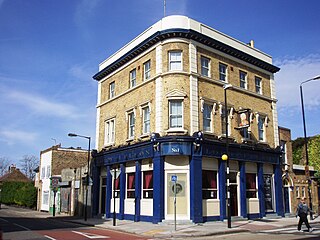
The Lord Nelson Ground was a football ground and the home of Millwall Rovers Football Club from 1886–1890, the team who went on to become Millwall. The ground was situated behind the Lord Nelson pub on East Ferry Road on the Isle of Dogs, East London. It was the second stadium that Millwall have occupied since their formation as a football club in 1885. Millwall played a total of 101 games at this ground, winning 59, losing 30 and drawing 12.
William Wallen Junior (1817–1891) was an architect and surveyor in London. He is the son of William Wallen Sr. (1790–1873) also an architect and surveyor. The Wallen family was linked to British architecture during the 19th century.
Glengall Road was a football ground and the home of Millwall Rovers Football Club from 1885–1886, the team who went on to become Millwall. The ground was a piece of wasteland, which was converted into a football pitch in the summer of 1885. It was situated at the west end of Glengall Road, on the Isle of Dogs in East London. This street has since been divided into Tiller Road and Glengall Grove, with Glengall Bridge in between. It was the first stadium that Millwall occupied since their formation as a football club. Throughout their first season of existance, Millwall played 24, won 17, lost four, and three games were drawn. They scored 45 goals and conceded 28.

















